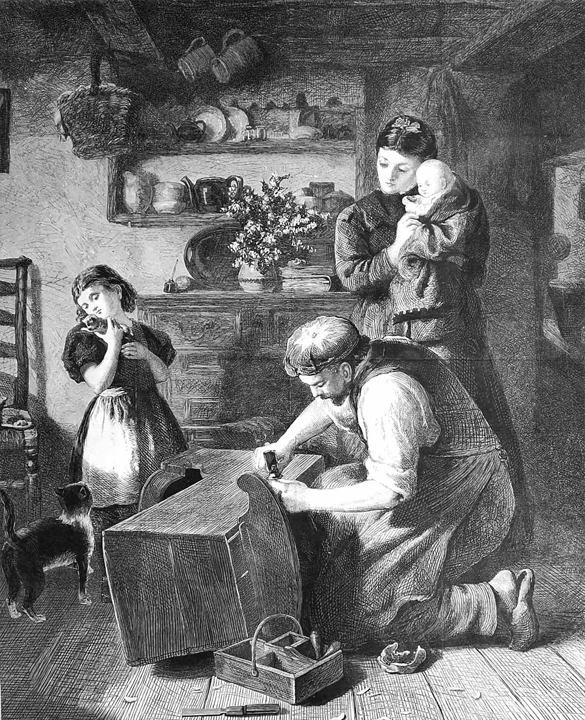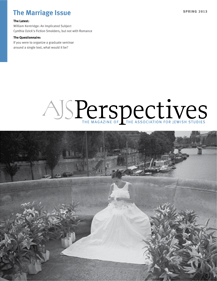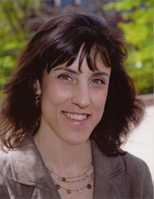
Intermarriage, like all marriage, is a relationship of power. How the power is divided depends on two things: gender and who negotiated for what, either before or after saying “I do.” If intermarriage has the potential to strengthen the Jewish people (along with institutions of education, such as summer camp or trips to Israel), it is critically important to understand the influence of the gender of the Jewish member in the marital union. Analyzing gender—the roles of both men and women combined with the relationship between the two sexes—is key to a full understanding of the meaning of Jewish intermarriage because gender informs how men and women raise children. My research focuses on heterosexual marriages, therefore much remains to be understood about the gender dynamics within same-sex intermarriage regarding parenting Jewish offspring.
How intermarried women and men experience parenthood is essential to increasing the likelihood that they will raise children to identify as Jews. When a Jewish woman intermarries and becomes a parent and when a Jewish man intermarries and becomes a parent, their experiences are different. The influence of becoming a parent on their respective Jewish identities, however, is surprisingly similar. Jewish identity is maintained, transformed, and reinvented in ways that are authentically meaningful to people who self-identify as Jewish and intermarry. It also demonstrates why intermarried Jewish men are believed to raise less Jewish children than intermarried Jewish women (Sylvia Fishman and Daniel Parmer, Matrilineal Ascent/Patrilineal Descent [Brandeis University, 2008]).
My qualitative research indicates that when people who are intermarried become parents, they also become more conscious of Jewish identity and of Judaism. Women who participated in my study described intensified Jewish identities, increased religious practices, or both. Although they may have become “more Jewish” once they became mothers, a typical American Jewish pattern, whether they had intermarried or not, the extent of their change over time suggests that being Jewish while married to a non-Jew usually heightened women’s consciousness about being Jewish. When Bonnie Aaronson planned her 1981 wedding, she had a very strong cultural and social identity as a Jew, but she was not a religious person. However, in the late 1980s after Bonnie had two children, she became actively involved in her temple and co-chaired a committee that created an alternative High Holiday service. Interviewed nearly twenty years after she wed, Bonnie remarked, “I have changed pretty dramatically in terms of my Jewish practice and observance . . . in the course of our marriage.” Among the intermarried Jewish women I have interviewed, having children made them decidedly proactive about making Jewish connections, about observance, and about Jewish education. The experience of having children also forced women to come to terms with the inadequacies of their own Jewish upbringing and to look for creative ways to teach their children (and themselves) about Jewish heritage.
Men may also experience an awakening of their Jewish identity when they marry and become parents, regardless of whether they intermarry or in-marry, due to greater communal opportunities. Historically and at present, the organized Jewish community directs much of its programming toward family units rather than to single Jewish men or women. Still it appears that intermarriage influenced a deepening of men’s Jewish identities in relation to their Gentile-born spouses and through becoming fathers. For Charles Revkin, being Jewish meant being part of a community and he acknowledged that it became more important as he got older. “It was a combination of circumstances,” Charles explained, “where I married someone non-Jewish and then . . . I knew I wanted to raise my kids Jewish. I know mothers tend to play an important role in that. Here we were not gonna have a Jewish mother, so it’s almost like an overreaction to make sure it gets done.” Assuming a proactive role regarding the children’s Jewish upbringing became a significant component of Jewish identity for some intermarried fathers. The shift over the course of one’s life could be striking. During his college years Allan Benjamin preferred to “pass” as a member of the (Christian) majority rather than joining a Jewish fraternity, but after intermarrying and becoming a father, he accompanied his children to Tot Shabbat and listened to Jewish CDs. Allan reflected, “As the kids grow, I’m becoming more open, more Jewish. I’m now somehow a board member of the Jewish Community Center. Seven years ago, I’d be looking at you like ‘where is the JCC?’” Although reawakening of Jewish identity in a father is similar to the experience of the Jewish mother, the men’s parenting is often secondary to his professional pursuits.
Although the men who participated in my research are invested in trying to balance or integrate their careers with fatherhood, the social reality of finding time for involvement with their children is an uphill battle. The non-Jewish wife of a Jewish man who intermarried in 1997 said that she was glad to have a Jewish family, but the extent to which they were Jewish would be his responsibility. Her reasons were not an outgrowth of feminist thinking, but rather stemmed from the reality that she is not Jewish and would not know how to go about it. He pointed out, “The only problem with that theory is that I’m at work 60 or 70 hours every week. ” There was not much time to ensure his children’s Jewish cultural or religious education. Consequently, the children attended a Conservative Jewish day school from kindergarten through second grade where they were exposed to more practices of Judaism than their father. The family transitioned the children to a public school in 2010, and their home life does not include Jewish ritual or observance. It remains to be seen to what extent this father will be able to foster his children’s developing Jewish identities without the built-in support of a day school environment.
The challenge for intermarried men raising Jewish children is the tenacity of traditional gender roles. For the most part, men continue to be the main breadwinners for their families while women continue to be the information gatherers and social organizers, maintaining greater influence than their husbands over children’s ethnic and religious upbringing. Women’s hands rock the cradle, so to speak. As a result, men’s presence where Jewish identity is nurtured (at home, the community center, the school, the synagogue) is more limited. Gender will persist in influencing the disproportionately low transmission rate of Jewish identity to children of intermarried men compared to intermarried Jewish women so long as “men’s work” outside the home continues to be more valued than “women’s work” inside it.
Jewish continuity depends on how the respective movements within Judaism respond to intermarriage and interact with the individual people involved. The acceptance of patrilineal descent by the Reform and Reconstructionist movements allows children of intermarried parents to be counted as Members of the Tribe. It now remains for the Conservative movement to validate the status of the children of intermarriage and to acknowledge the influence of the roles of Jewish husbands and fathers, allowing them to retain their affiliation with the movement of their choice. Intermarried Jewish men can raise Jewish children as effectively as intermarried Jewish women as long as they understand that it is their responsibility to do so, ideally in partnership with their spouses. The Jewish community must reinforce their effort by validating their familial contributions. Men can become Jewish role models in their families even if their own fathers were not. For example, intermarried Jewish men can light Shabbat candles, read Jewish bedtime stories, and transmit their love of Jewish culture to their offspring. For children of Jewish fathers to become as strongly identified Jews as the children of Jewish mothers requires that intermarried Jewish men step up to the parenting plate. Perhaps then the Conservative movement will include their children as full members of klal yisrael rather than labeling them as “patrilineal Jews.”


 Keren R. McGinity is the author of Still Jewish: A History of Women and Intermarriage in America (NYU Press 2009), a National Jewish Book Award finalist, and Marrying Out: Jewish Men, Intermarriage, and Fatherhood (Indiana University Press 2014). She is affiliated with the Hadassah-Brandeis Institute and the Cohen Center for Modern Jewish Studies at Brandeis University. McGinity earned her Ph.D. in history at Brown University, where she was also appointed as visiting assistant professor, and was subsequently the Mandell L. Berman Postdoctoral Research Fellow in Contemporary American Jewish Life at the University of Michigan's Frankel Center for Judaic Studies. McGinity graduated Phi Beta Kappa from Rutgers University and earned a master’s from Harvard where she was awarded the Dean’s prize for outstanding thesis. She was the inaugural graduate research fellow at the Jewish Women’s Archive and now serves on the JWA’s Academic Advisory Council. McGinity also advises the Crossing Borders Bridging Generations Project at the Brooklyn Historical Society, the Jewish Outreach Institute, and the Leadership Council of Temple Beth Avodah in Newton, MA. She created and runs the website
Keren R. McGinity is the author of Still Jewish: A History of Women and Intermarriage in America (NYU Press 2009), a National Jewish Book Award finalist, and Marrying Out: Jewish Men, Intermarriage, and Fatherhood (Indiana University Press 2014). She is affiliated with the Hadassah-Brandeis Institute and the Cohen Center for Modern Jewish Studies at Brandeis University. McGinity earned her Ph.D. in history at Brown University, where she was also appointed as visiting assistant professor, and was subsequently the Mandell L. Berman Postdoctoral Research Fellow in Contemporary American Jewish Life at the University of Michigan's Frankel Center for Judaic Studies. McGinity graduated Phi Beta Kappa from Rutgers University and earned a master’s from Harvard where she was awarded the Dean’s prize for outstanding thesis. She was the inaugural graduate research fellow at the Jewish Women’s Archive and now serves on the JWA’s Academic Advisory Council. McGinity also advises the Crossing Borders Bridging Generations Project at the Brooklyn Historical Society, the Jewish Outreach Institute, and the Leadership Council of Temple Beth Avodah in Newton, MA. She created and runs the website